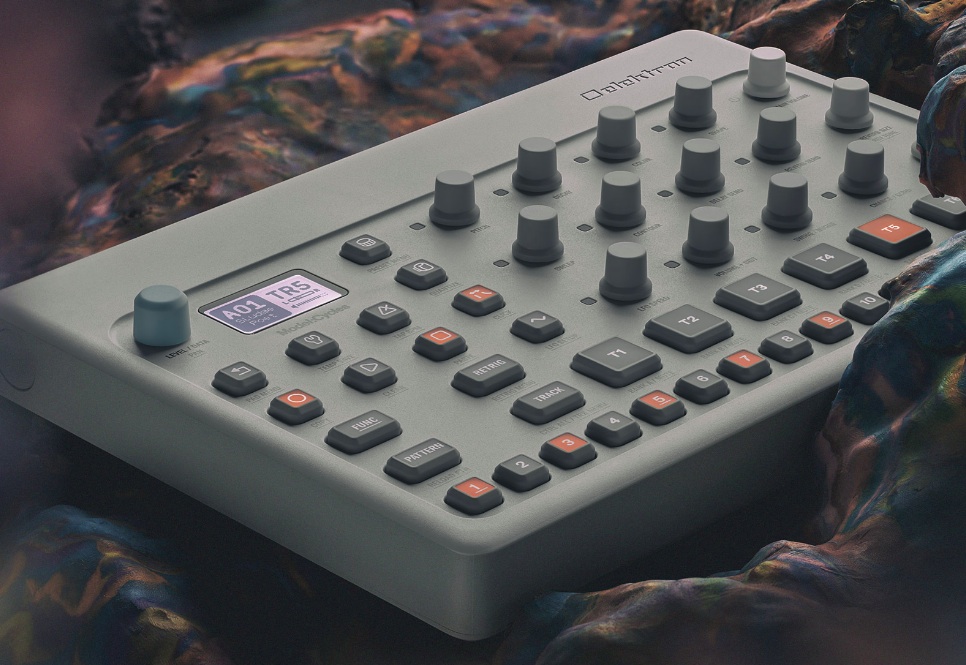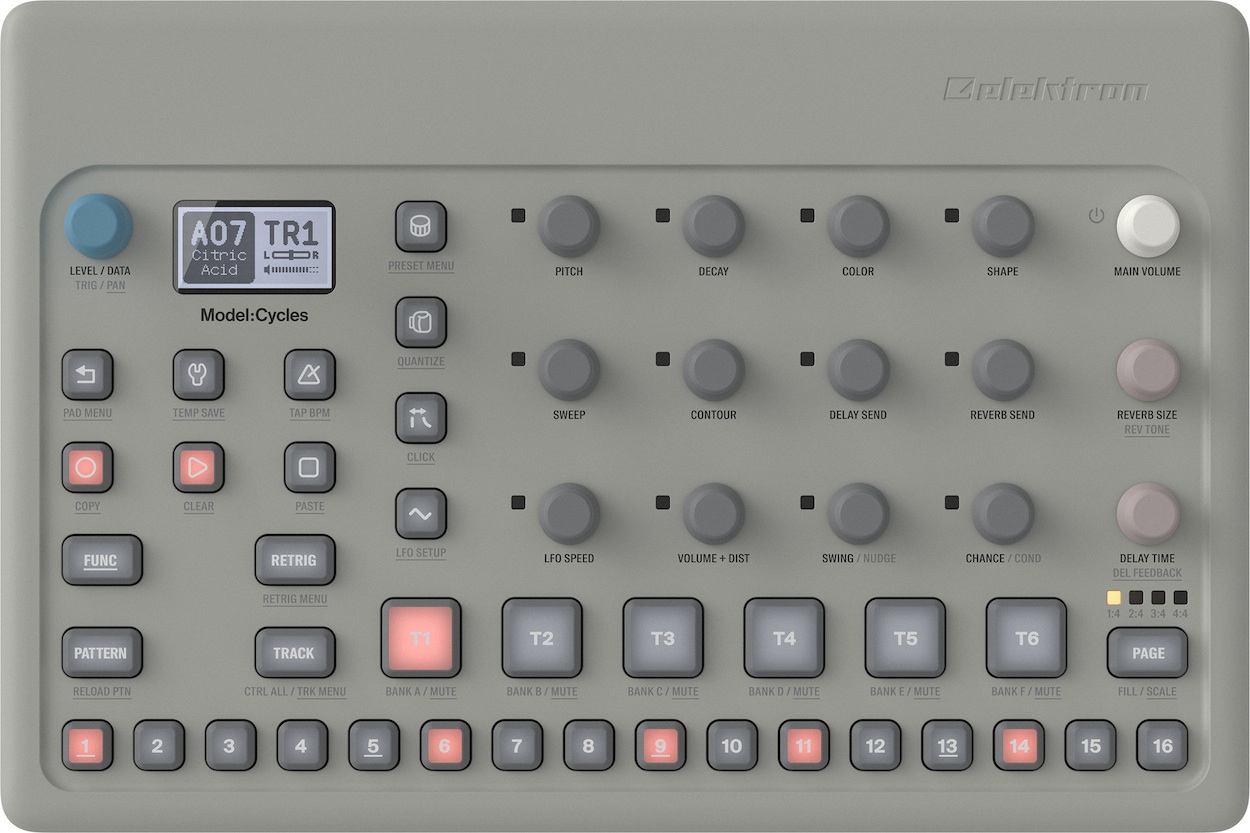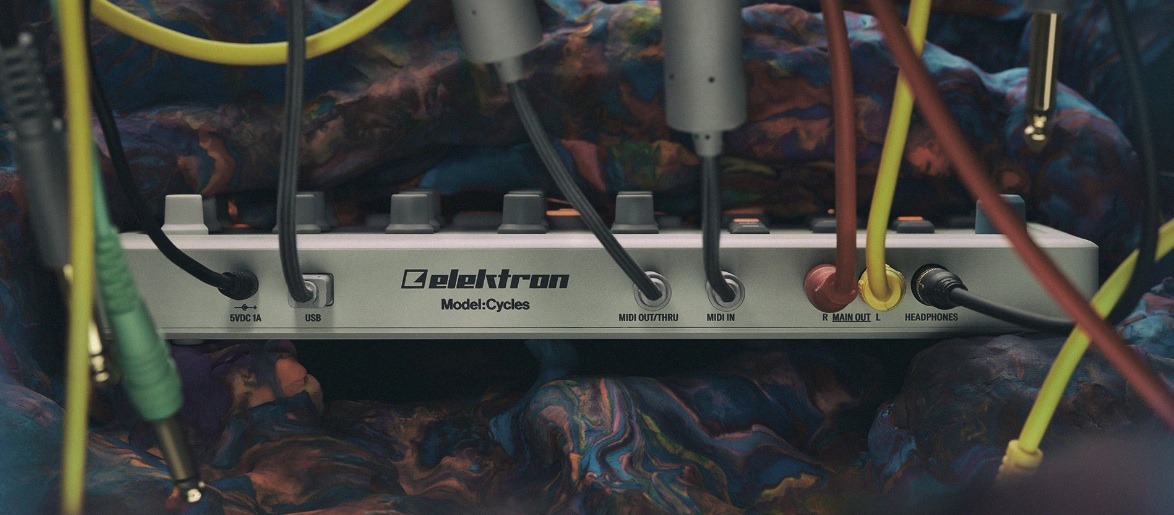New Gear Review: Model:Cycles Groovebox by Elektron
Recently, Swedish stalwarts Elektron began a slow rollout of a new product. At first, they showed only glimpses of its interface, covered in psychedelic metallic ooze that kept faithful Elektronauts guessing at what was to come.
Would it continue Elektron’s trend toward smaller, more affordable products, bringing their famed sequencer and crisp sonics to a wider base of users than ever before?
Many guessed that it would follow in the steps of the Model:Samples (a box I reviewed back in 2019), a stripped down version of their widely successful Digitakt.
Those guesses were right. Elektron unveiled the Model:Cycles to near immediate acclaim, leaving potential customers scrambling to get their hands on one after the first round of machines sold out nearly immediately from online retailers.
Taking its cues from the larger Digitone, a four-track FM synthesizer that pairs the typically convoluted synthesis method with subtractive-style filters and a few carefully chosen effects, the Model:Cycles shows that Elektron are continuing to think about FM synthesis differently.
So how does it fare compared to its older, bigger brother?
Features
The Model:Cycles is quite easy to get acclimated to quickly, given that most of its design is knob-per-function. The core of the machine is based around six Tracks that feature what Elektron call “Machines”. There are, unsurprisingly, six Machine types—Kick, Snare, Metal, Perc, Tone, and Chord. Each of these serves a different sonic purpose, though it’s easy to ignore their intended uses and stretch their boundaries pretty quickly.
Kick and Snare are quite self-explanatory; Metal is used for all manner of cymbal-like sounds; Perc can be used for any type of drum sound but also can be used for melodic elements; Tone is perhaps the most flexible of the bunch, as it’s essentially a two-operator FM voice with built-in limitations; Chord is similar to tone except that it uses a selection of preset chord options paired with a wavetable-based sound source.
One of the best features of this groovebox is that each of the six Tracks can load any of the six Machines, so you aren’t limited to any preset combination of sonics. Because of this, the Model:Cycles can work as a traditional groovebox—Kick on Track 1, Snare on Track 2, Metal on Track 3, etc. But it can also be a totally melodic tool if you load up Tone or Chord on every Track, making it possible for the Model:Cycles to be a very adept machine at deep ambient tones, hyperactive melodic chord changes, or anything in between. On a similar bent, if you don’t want to use the Model:Cycles for anything melodic, you can have six Tracks of very capable drum/percussion sounds—load up six variations of a Kick sound and go from there.
There is but one LFO per track, though it has seven different waveforms and can be sent to nearly any destination you’d like in the Machine’s architecture. The LFO setup menu allows you to select if the LFO will fade in or out, or where it will start in its waveform cycle, which is handy for getting more out of it.
The Amp envelope is possibly the simplest feature of the whole unit, as it only offers a Decay knob and no control over the attack or other elements of the envelope. A workaround is available using the LFO when “Envelope” is selected as the waveform and Depth is set to negative values, producing a slow attack. However, this sacrifices the use of the LFO for other modulation duties. Given that Elektron has deemed the Model:Cycles a ”groovebox” this decision makes sense, but it would have been nice to have a more fully-featured envelope; at the very least an Attack knob would have added a much broader array of possible sounds from the Model:Cycles.
The sound engine of the Model:Cycles is quite easy to grasp quickly. Each Machine is fed into a per-track overdrive, into an amp volume level with full panning, and finally into the main mixer output. There’s a per-track reverb and delay send; these effects are global and like other Elektron gear, they sound great. The reverb can get nice and big, adding a lot of width to the sound. It can also be set to infinite decay, which is very nice for drone and ambient sounds. The delay engine isn’t very tweakable, with controls for just time and feedback, but it works well and is definitely a welcome inclusion. Hitting the Stop button twice cuts all sound off immediately, just like on the Digitakt/Digitone. This is nice for when something is trailing off or the delay is feeding back excessively.
The small LCD screen in the top left corner is well illuminated and easy to read; it displays information about each Machine, pattern information such as tempo and name, and functions as the main way to view the Configuration menu. The rear of the unit sports MIDI in and out/thru connections via mini jacks, though the Model:Cycles comes with the necessary full size adapters. There is a full size 1/4” stereo output, as well as a headphone output. Importantly, there’s a mini USB jack that can allow the unit to run in class compliant audio mode, though the Model:Cycles doesn’t have the ability to stream all six of its Tracks individually through Elektron’s Overbridge software.
A portable battery pack is reportedly coming soon, which will allow you to power on the Model:Cycles on the move. This is exciting because the box itself is incredibly lightweight, though it felt sturdy enough to use in both studio and live performance situations.
Like both the Digitakt and Digitone (and the Model:Samples), the Model:Cycles uses a non-volatile storage called the +Drive to store information on the machine. 96 projects can be saved, each of which can contain 96 patterns of up to 64 steps each. A pattern can contain up to 70 preset sounds, although the +Drive has no set limit on number of presets that can be stored. Suffice to say, you won’t be running out of storage room for either presets or patterns any time soon.
One of the most impressive things about any piece of Elektron gear is the sequencer functionality. Every single step features what are called “Parameter Locks”, which essentially mean any of the knobs can be tweaked while holding down a step and those changes are applied to that step only. The sequencer on the Model:Cycles adds even more variability into the mix with its dedicated Chance knob, which controls the percentage that the steps are actually triggered. Set to 100% and that track will play 100% of the time; set to 50% and that track will only trigger half the time. Since this is per-track, just playing with this function will give you morphing, evolving sequences that would be impossible to replicate with other gear. It’s also just a lot of fun!
There is also a Retrig button, which again is per-track and can be set to whatever repeat setting you’d like, with variable length and decay values as well. Retrigs can be added using this button or after you’ve already inputted trigs (steps) by holding down a step and then using the Retrig button to manually input repeat values.
Like the Digitakt, the Model:Cycles boasts a Control All button, which when held, affects all Tracks at once. Hold the Control All button and lengthen the decay, and the decay of all six Tracks is adjusted. Want to quickly pitch everything up on octave? Control All and a quick tweak of the Pitch knob, and that is easily accomplished. This is also a quick way to turn up or down the volumes of all the Tracks, which is important when using the Model:Cycles in class compliant audio mode in your DAW because the Main Volume knob has no affect in this situation.
As mentioned, there are a host of preset sounds to choose from that can be loaded from the menu. Each step can have its own preset sound provided you add that preset to a folder labeled “Locks” first. This is important, as each of the six Tracks are monophonic. The ability to recall presets and “kits” (i.e. six presets in a folder at once) is a great workflow enhancement. This is missing on the Digitakt and has been a much-requested feature; the fact that this is included on the Model:Cycles is a great time saver.
Another area where the Model:Cycles shows its deep Elektron heritage is its impressive MIDI spec and functionality. Each Track has its own MIDI settings, which can be accessed by hitting Func + Track, bringing up the Track menu. Here, you can turn MIDI on or off for each Track, set the keyboard transposition per Track, and choose what MIDI note the pad is set to. Several Tracks can be set to the same MIDI channel, which adds to the expressiveness of the machine when used with other gear.
In Use
The fact that the Model:Cycles comes with a plethora of well-made presets and preset patterns gives you a handy introduction into what is possible with the machine. There’s all manner of tones and timbres; if you didn’t know this was an FM-based engine, it’d be hard to guess that FM was the source of all these various sounds.
Using the sequencer will be second nature to previous Elektron devotees but it’s not hard to pick up the basics if you haven’t had any experience with their other products. When the Record button is pressed, the bottom row of 16 pads function as a step sequencer, with four available pages and a max length of 64 steps. When the Record button is unlit, these same pads act as a chromatic keyboard for the currently selected Track. Holding down the Record button and hitting Play puts the Model:Cycles into Live Recording mode; this can be done with Quantize turned on or off, which means that you aren’t limited in any way to a static 16-64 step sequence. The Page button on the right side of the Model:Cycles moves through each of the pages and also functions as a “Fill” button when held down if the sequence is playing. This is a feature that is carried over from the Digitakt and makes adding quick rhythmic fills with the Model:Cycles quite fun and intuitive.
I found it much easier to play the Track’s Machine engines with these smaller chromatic buttons as opposed to the larger Track pads themselves, even though the Track pads are velocity sensitive and much larger. As mentioned in my review of the Model:Samples, the Track pad buttons don’t have a lot of give or responsiveness, which could be either a positive or negative depending on your own finger drumming experience. They won’t be a replacement for a nice set of MPC pads, or even the pads on Native Instrument’s Maschine series.
The pads can be set to a fixed velocity, which does aid in making sure they are triggering no matter how hard you hit them. Elektron have included the ability to route the velocity to quite a number of settings in the Machine engines, which does aid in making them more expressive. The depth of this modulation can also be set manually and has both positive and negative values—set the destination to pitch and a negative value and the harder you hit the pad, the lower the pitch of that particular Track goes. There’s a lot to explore here, which makes it slightly more frustrating that the pads aren’t the most friendly to your fingers. That being said, it’s a fine line between too responsive and not responsive enough, so to use the old adage, your mileage may vary.
That being said, the Model:Cycles truly sounds great, as all manner of crisp sounds can be coaxed from its six Machine types. I found it hard to focus on judging it objectively because I had so much fun just playing with the various Machines, which is a good sign for any new piece of gear.
It’s possible to set a max volume for the dedicated headphone output, which is a nice touch to prevent you from blowing your ears out! Little details like this really show how much thought went into the Model:Cycles.
To Be Critical
There was very little that bothered me about the Model:Cycles. The main volume control doesn’t have any effect when using the Model:Cycles in USB class compliant audio mode, but that’s not a huge problem given that you can turn down the volume of each individual Track.
Again, the pads are the same size and responsiveness as Model:Samples, which might leave some users wanting more. I did find that it’s a bit too easy to overdrive the master output when using the USB class compliant audio, something that could be addressed in a firmware update.
Summing it Up
As you can probably tell, the Model:Cycles is going to be a huge hit with a lot of people, especially given that it is $299 brand new. The overall sound is crisp, deep, and focused, which is even more impressive given the price. It can be used as a full groovebox to compose and produce entire tracks, it can be used as a MIDI sequencer for other gear, it can even just be a very nice kick drum machine!
I really didn’t want to give the Model:Cycles back to Elektron because I quickly integrated it into my own studio practice. Suffice to say, I’ll be finding another one as soon as online retailers replenish their supply. Elektron has done a fantastic job taking cues from their previous products and funneling them into a smaller, more portable tool that is going to please a lot of musicians for years to come.
Leo Maymind is a producer, DJ, and writer living in Los Angeles, CA. He is obsessed with sound, and you can reach him at lmaymind@gmail.com.
Please note: When you buy products through links on this page, we may earn an affiliate commission.










[…] Would it continue Elektron’s trend toward smaller, more affordable products, bringing their famed sequencer Read more… […]